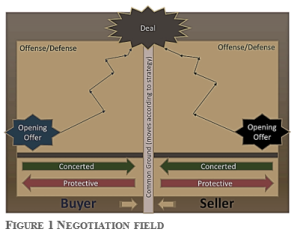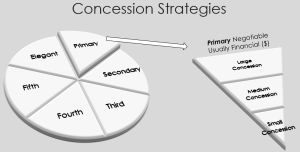1 Chapter 1: Negotiation Basics
We will begin the study of negotiations with role play. This experiential learning exercise will build a positive mindset for the learning of important concepts related to negotiations.
Role Play
Students will be split into groups of two (buyer and seller). You will receive a role play document password from your facilitator. Each person should read their document for understanding. Prepare for the negotiation. Then video the negotiation with your partner and upload it to your facilitator. You will receive personal feedback based on the interaction of the negotiation recording. Work hard to make a deal.
RULES:
- Do NOT share your documents with the other negotiator.
- Do NOT discuss your role play after you make a deal.
- Prepare – 20 minutes.
- Role Play for 15 minutes (video the process – check your audio and video settings prior to the role play.).
- Upload Video per facilitator instructions.
- See debrief of exercise – YouTube channel
NOTE: Role Plays are located in the appendix – careful not to view the opposing side of the negotiation until after the debrief.
Negotiation Introduction
Negotiations is an event that occurs in all phases of the sales process. Negotiations may be something as simple as making a trade to get time with a new decision maker or as complex as a multi-year agreement with a fortune 100 company. For this text, we will keep the study of negotiations elementary; primarily considering a negotiation as a single event during a sales/buying process. Although the study will be basic, one may find this segment fascinating as it will help you in your personal life as well as your professional life. Skilled negotiators are great communicators. They get to the heart of the matter with the other party involved. Two critical skills of the negotiator are 1) Listening…which means that you are not waiting to talk (think about that for a minute) and 2) Questioning…to get the knowledge you need that will lead to a better negotiation outcome.
All sales and buyer engagements follow a process. Some negotiations are focused on one product or service with no personal or professional relationship involved. Other, more common negotiations are of a concerted effort and strive for a longer-term relationship focusing on multiple products or services over a longer period.
Our focus will be on a concerted sales process model that cultivates profitability for firms over a longer period. Although there are variations of sales processes depending on the industry, we will use a common engagement model adopted by firms that produce long-term partnerships with clients at a corporate level.

|
Figure 1 Negotiation field |
Long-term partnerships require negotiations with Concerted efforts to be effective. Protective elements must also be present to secure profitability. Well-planned strategies will guide us to work with the other party to develop a plan that works for both entities. In figure 1, we can envision a field where both parties are trying to reach a deal. Both must be protective of their position. However, they also must have some concerted effort to drive the deal up the field using questions to gain knowledge, proposing scenarios, preparing for trades; all the while following a concession strategy that was planned prior to the negotiation engagement. Its offense and defense working toward a deal that works.
Both Buyers and Sellers must exhibit an ability to work with a concerted effort and balance with the protection of profitability. It is better to walk away from a deal than to enter into an agreement that will erode planned profitability.
Negotiation Rules of Engagement
There are some primary rules of engagement when negotiating. They are as follows:
- Build Rapport.
- Seek to Understand.
- Expect Ranges of Value.
- Position Value Strategically.
- Target Your Outcome.
- Concessions are Key to Winning.
- Closing is Final.
- Emotions are Expensive.
- Use of Tactics.
- Anticipate Actions.
Using common rules of engagement, a negotiator positions themselves for winning a profitable deal. Let’s discuss these more in-depth.
- Rapport to bridge the discussion – Rapport is a social element that is important to any personal or professional interaction in most cultures. Understanding the culture of the individual or entity may be critical to a successful outcome.
- Seek to understand – Asking questions to understand the other party’s motivation to make deals advantageous to your position. Knowledge is powerful.
- Expect ranges of value so that you are not surprised – One of the dangers in negotiations is to assume a value that the other party may put on their position. Always expect the other party to suggest a value that is out of your range of rationale. The reason the value may be out of your range of rationale is because you have limited information of the mindset of the other party. Or the other party is simply using a starting value as a tactic to set you back in the negotiations. In either case, a skilled negotiator will expect unfamiliar circumstances.
- Position your value strategically – Setting targets of value in a range from high to low are one of the most important parts of the negotiation. This process should be planned prior to the engagement with the other party.

|
Figure 2 Targets |
- Target your desired outcome – A negotiator must be confident in the target value ranges that they aim to achieve (see figure 2 Target Positions). Setting targets is imperative to a sound strategy. The negotiator should be prepared with a desired outcome. Then, positioning starting points of value is critical to ensuring that you get the target value through the negotiation. It is very difficult to change a position in your favor once you have given up a lower value to sell or agreed to purchase at a higher value.
- Concessions are key – Concessions must be planned in advance of the negotiation. In addition, never give up value unless you get something of value in return. A skilled negotiator uses the knowledge available to them and proposes creative scenarios that help you achieve your objective of the target. There are sometimes many negotiables that can be used in the negotiation. Skilled negotiating includes finding these negotiables and including them in the deal. Proper concession planning will help you achieve your target.
A skilled negotiator concedes with a rational process. If you are the seller, a rational process would include a methodical approach of offering your product initially at your high range, then, conceding by making trades to stay at or above your primary target, eventually lowering the price of your primary negotiable to achieve the deal within the planned target range. If a seller offers a low price to the buyer, then tries to increase the price during the negotiation, the rational negotiation behavior may be questioned. Therefore, complicating the process of getting to a deal.
Proper Concession Strategies:
Concession strategies should always have more than one negotiable. However, often, buyers and sellers do not consider more negotiables than their primary negotiable that is most of the time, money.
How to make a proper TRADE
As the negotiator considers multiple negotiables, the effort to make an effective trade has a process. The following is an example:
- Seller | “I appreciate you walking me through the process and sharing the challenges and cost implications of the overtime that the paint drying situation is causing. I have experience in this field. If I could show you a product that could cut the dry time in your production by 83%, would you be open to discussing a business relationship?”
- Buyer | “I’m not sure, we have been doing this a long time and even though it causes us some pain, it still works ok.”
- Seller | “I understand. I have seen others stay with the process for a little while. Then, they experience our product and the impact. It’s a change for the good.”
- Buyer | “What do you have in mind?”
- Seller | “If I could offer my paint drying equipment at an introductory rate of 10% off for a six-month test and assign an engineer to perform a full impact study. Would you be willing to allow us to do a full presentation for your CEO and CFO if the test is successful?”
- Buyer | “I would be willing to try that.”
- Seller | “Ok, I will draw up a six-month agreement at 10% and engineer study for the six-month revenue commitment and a presentation with your senior leadership by November 20th. Will you sign by the end of the week?”
- Buyer | “Yes. I can commit to that agreement.”
Trades start with a proposal that may be receptive to both sides. The other side will counter with a negotiable, deny it, or be agreeable to it. Once both sides agree there is common ground, the initiator will make a formal request for the trade. Trades are used interchangeably with the negotiables. Be sure to entertain all of the negotiables that are available.

Picture negotiables as a pie. Only serve the pieces of pie when and how you want. An example of the negotiables used during the negotiation in a property development for the where buyer is seeking some owner financing follows:
Buyer Seller
Primary = Money (Cost) Product of interest (Land)
Secondary = Terms of Payment Interest for debt
Third = Lease vs. Buy Lease vs. Buy
Fourth = Mineral Rights Mineral Rights
Fifth = Charity gift Monument with Park (grandfather)
Elegant = Name of Building Expertise of architecture
As the Buyer and Seller expands with creative negotiables, there will be higher percentages of deals to be made. Planning and anticipating provides more pieces of the negotiation pie to be revealed to make the deal.

Elegant negotiables have little cost to the person proposing them. But sometimes can have great value in the mind of the other party.
When negotiating, never give up something unless you get something of value in return.
When making a concession, offer the larger value of the negotiable first. Then, work through the negotiation using smaller numbers to show the other party that the attempt at making a deal is coming to an end. When the negotiator gets to the “delta of the pie”, this demonstrates near a walk-a-way and each side needs to be more creative by including more negotiables into the mix of the negotiation.
- Closing is final – Once the deal is done, there will be an informal self-assessment by the parties involved. To ensure that the other party gets a perception of a good deal, how you close can be as important to the negotiating as the value you achieved for your product or service. Humility and respect are a negotiator’s best friend. A skilled negotiator never shows excitement when they are about to close a profitable deal. It is in poor taste to disrespect the other negotiator with a quick acceptance of an offer, if you are getting the better part of the deal. A reluctant acknowledgement of the value and slower process to commit to close will give the other party a good impression of you and leaves a willingness to work with you again in the future.
- Emotions are expensive – People are passionate about their money. But they are more passionate when they have a sentimental affiliation to the object of negotiation. A skilled negotiator uses information, achieved through quality questioning, to uncover emotional elements of the other party’s position. Sentimental value can be used as a positive influence during negotiations. For example, if honor can be given to the object of negotiation, the other party may put a great value on the honorable efforts and agree to a lower price. If the negotiators never understand any emotional affiliations, roadblocks may go up that become very difficult to pass. Respect the other party’s emotional concerns. Learn as much as you can and use it in negotiation to create new scenarios or to make trades of value for honor and respect, if possible. Community or charity are two negotiables that are sometimes a great part of the negotiation process. However, it takes the right object of negotiation and situation to include these elements.
- Use of tactics – tactical use of influences or positioning is an important part of creating power in the negotiation. By using positioning statements, third-party references, and peer-reviewed data are ways that a person can create power in the negotiation. Strategically use of this power will determine the effectiveness of effort.
- Anticipate – being prepared for whatever is released from the other party is important to maintaining a winning mindset in the negotiation. Stretching our range of rationale or thought process of expectations will give us a sense of security when a seemingly unreasonable request comes from the opposing party. For example, be prepared for the other party to ask for 20% when you think it is reasonable for 5%. By anticipating, the emotions stay in check, and you follow your concession strategy without giving away your position in the negotiation.
Types of Negotiations
What makes a negotiation more protective or more concerted? Should a negotiator be more territorial and competitive in certain situations? Are negotiations different if this is a one-time deal or when it involves a corporate engagement? These are important questions to ask. Primarily considerations fall in the extreme opposites of negotiation levels that expand between a highly protective position (SIMPLE) and a cooperative/concerted approach commonly found in corporate engagements (COMPLEX). The event type of negotiation can best be determined by the relationship between parties (or desired relationship between parties). For example, a negotiation for a used motorcycle at a business which you will never see again is certainly different than a negotiation with a strategic partner relationship between larger corporate entities. The negotiables are different, and the desired relationships are different.
Simple negotiations do not equal easy. And complex negotiations do not equal hard. They are elementarily different. Even with the differences in the relationship expectations in the future, the rules of engagement for the negotiation itself still should have some of the same attributes (rapport, seek, expect, position, target, concessions, closing, emotions, tactics, and anticipate).
Other factors that may affect the negotiation are as follows:
- Skills of negotiator.
- Knowledge of product, service, and other negotiating party.
- Pressures of influential forces.
- Number of negotiables used in the negotiation as value.
Needs and Desires
Negotiables can be anything that you are able to attach value. As discussed with things of honor, sometimes these can have the highest value to a person. When trying to achieve the deal, remember that people have personal needs and desires and professional needs and desires.
Making a deal that secures the need for the other party can be a proper way to proceed if you do not have exactly what the other party is looking to acquire. For example, I desire a new Corvette. I only need a good dependable car to transport me from home to work. I am willing to pay more for the Corvette because I have a stronger desire for the Corvette. It appeals to me more than the minivan that is next to me at traffic light. This concept is no different in a corporate engagement. A firm may need a customer relationship management (CRM) system. Their sales team could probably get by on a rudimentary platform for documenting sales visits. However, the CEO may desire a tool that can assist with strategic planning and forecasting next quarter’s profit numbers. To achieve this, she may desire a Corvette of CRM platforms, or at least the add-ons for additional functionality.
Skilled negotiators take advantage of the understanding of fulfilling the needs and desires to make a more profitable deal. If you are selling, desires get more profit. If you are paying, desires will cost you more. Using your skills to change values in the mind of the other party is an art that is crucial to a profitable deal.
Trained and the Untrained
Individuals that are skilled in martial arts know that there is a difference in a person trained in the art of warfare and the individual that is not. You can see it when they fight. When two people are playing music, the level of skill can certainly be heard. As with Music and War, so shall it be when a skilled negotiator is involved with someone that has no negotiation skill. Negotiations and sales are an art and a science. Just as with music or warfare, there are processes and fundamentals that are critical for success.
Untrained (unskilled) negotiators consider two primary negotiables, the object they want and the money they are willing to give for it (or get, depending on if you are the buyer or seller). Skilled negotiators understand that sometimes there are many negotiables to explore. Your job as a skilled negotiator is to understand the needs of the other party and work toward a deal that satisfies the need for them and achieves the planned deal for you or your party.
Knowledge
Knowledge of the product or service is critical to the articulation of value during the negotiation process. Value comes from the knowledge of how the product or service will be of benefit to the other person and proposing a value that leads to profitable deals. Knowledge is a key component of all negotiations. A primary goal is to fully understand the who, what, when, where, and how regarding the situation.
Forces
Pressures of influential forces are real. Left unchecked, they can have a serious effect on the negotiator, and ultimately, the outcome of the negotiation. Pressures related to the simpler negotiations could be related to the financial situation. For example, the used car salesman needs one more car to sell by Friday to get the big bonus. So, he may not hold firm on price compared to the guy that has already made the bonus for this month. Another example may be the sales metrics mandated by the sales manager in a fortune 100 firm. If she doesn’t make two more sales this month, she may get a warning of employment loss. Management of pressures must be a priority in negotiations.
Review
- Defenseless strategies yield ultimate defeat.
- Protective-only positions yields lower perceived value, poor or no deals.
- Determining the goal for the negotiation (prior to negotiating) is critical.
- Value can be influenced by a skilled negotiator.
- Anticipate the ability of the other person to negotiate
- Prepare for response
- Use tactics to take the offense to your desired position
- Defend your position
- Concessions must be planned and used appropriately
- Understand the other party
- Determine how to satisfy their position while protecting yours
- Help the other person achieve their overall goals without giving away your position
- Long-term relationships require satisfaction of needs and desires.
- o The value of desires is always higher in price – get more.
- o Needs can satisfy the position of the other party.
Chapter Overview – YouTube channel

